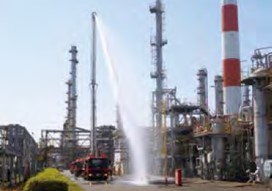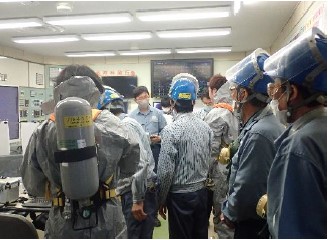Occupational Health and Safety - Equipment Safety
For zero equipment-related incidents
In order to make improvements to achieve the inherent safety of equipment, we analyze past equipment-related incidents and also conduct risk assessments to plan and implement measures to prevent the reoccurrence of similar problems.
Results
Number of equipment-related incidents that happened at Group companies in Japan
Former Showa Denko
- 2020: 4 cases (2 fires, 1 leakage, 1 deformation/breakage)
- 2021: 4 cases (0 fires, 1 fuming, 2 leakages, 1 deformation/breakage)
- 2022: 9 cases (3 fires, 1 fuming, 5 leakages)
Former Hitachi Chemical
- 2020: 7 cases (6 fires, 1 leakage)
- 2021: 3 cases (3 fires)
- 2022: 4 cases (4 fires)
All were minor incidents in which no people were harmed.
Measures to ensure equipment safety
The Resonac Group aims to enhance its ability to ensure equipment safety, and fosters Active Safety activities* to prevent a recurrence of past accidents and problems, while making continuous improvements in its safety systems, sensitivity and culture.
In order to further increase the effectiveness of our risk-based management system under which we plan, implement, evaluate and improve our risk reduction measures based on the results of risk assessments conducted at all stages including equipment design, operation, maintenance, installation and others, we are improving our existing management systems and risk assessment methods. We are also working to ensure safety through a range of examination boards and by sharing information about past incidents across the board.
- Promote design for inherent safety and ensure the appropriate management of design changes to prevent equipment-related incidents
- Conduct preventive maintenance, time-based maintenance and condition-based maintenance activities
- Conduct examinations for the treatment of chemical substances that are very hazardous or pose a high risk of incidents
- Analyze the fundamental causes of internal incidents and implement measures to prevent the reoccurrence of similar incidents
- Implement measures to prevent incidents across the board in reference to past internal and external incidents
For higher safety sensitivity, we are reviewing safety knowledge- and skill-related educational systems by job type and position.
We are implementing various measures to create a safety culture at our workplaces.
- * Active Safety activities: Activities in which we analyze past incidents and disasters and summarize the lessons learned from them in the “Active Safety checklist,” and then make use of the list to identify related risks and as an educational material to prevent the recurrence of similar incidents
Measures against accidents and natural disasters
We give first priority to the lives of people in the event of natural disasters, including earthquakes, typhoons and heavy rains. Moreover, in consideration of the impact of our Group’s product supply activities on society at large and the importance of fulfilling our supplier responsibility, we conduct risk assessments against disasters to implement damage prevention and mitigation measures. In particular, against earthquakes, we have identified equipment and buildings that need to be seismically reinforced in order to protect people’s lives and have been fostering effective anti-seismic measures for them. If an accident or a natural disaster that could affect the entire Group occurs, we will establish an emergency headquarters headed by the president and implement measures against the disaster, including those concerning activities conducted by the head office’s administrative departments in line with our predefined in-house rules, on top of the security and disaster control rules already in place. Also, our sites comply with the in-house security and disaster control rules with regard to their emergency organizations and action plans, and conduct drills regularly against emergency scenarios.
As our business domains expand, we are building a business system that is more resistant to disasters both in Japan and outside the country. For our business continuity plans (BCPs), which we have formulated in consideration of our product and business features, we are making revisions in response to changes in the business environment, including a shift toward telecommuting. We will further foster our business continuity management activities by clarifying challenges and meeting them through education and training.
TOPICSComprehensive Disaster Drill at Oita Complex
The Oita Complex conducts comprehensive disaster drills with the aim of improving the disaster response capabilities of related departments and strengthening mutual cooperation in the event of a disaster occurring in the complex.
On the day, a firefighting drill was held on the scenario of a fire caused by leaking equipment at Nippon Polyethylene Corporation, along with a rescue drill held on the scenario of injured workers during extinguishing operations. We consistently improve our disaster response capabilities by reviewing our performance at the drills, identifying problems and discussing countermeasures. We will promote activities to strengthen the disaster preparedness of the complex through conducting these practical drills on a regular basis.

Water discharge
TOPICS Emergency response drills at Higashinagahara Plant
In preparation for emergencies such as fires, explosions, and leakage of toxic substances, the Higashinagahara Plant conducts comprehensive disaster drills in spring and fall jointly with other companies operating within the premises. Comprehensive disaster drills in spring are based on a scenario that toxic gas has been leaked.
On the day, emergency response drills were conducted for the two primary objectives: "Can the workplace where the disaster occurred and each unit of the emergency response organization smoothly engage in an initial response?” and "Can we safely rescue victims in the event of casualties?" Although participants appeared tense, they were able to act as they had anticipated in advance. On the other hand, some room for improvement was identified in communications using premises broadcasting equipment and IP radios. Going forward, we will continue to conduct drills to improve the identified issues so that we can respond calmly and smoothly to any possible contingency.

Production section engages
in initial response drill
